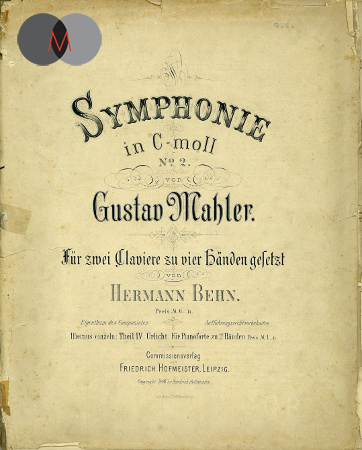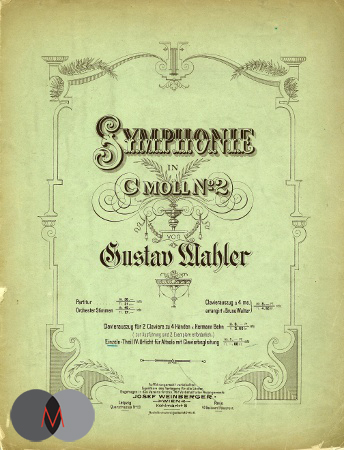“Resurrection” (in German “Auferstehungs-symphonie”).
The ink was barely dry on the score of his First Symphony in 1888 when Mahler began to toy with the idea of a new large symphonic work in c. The opening movement was soon completed and named Todtenfeier (Funeral Ceremony), but it then languished among his papers until 1891, the year in which he left the Budapest Opera to become conductor in Hamburg. There he attracted the attention of the great conductor Hans von Bulow (1830-1894), well known as a champion of new music. When Mahler played him Todtenfeier on the piano, however, Bulow covered his ears and groaned: “If what I have heard is music, I understand nothing about music. […] Compared with this, Tristan is a Haydn symphony.”
Mahler’s creative urge survived the master’s cruel words, but the Hamburg Opera now consumed most of his time and energy, and it was not until the summer of 1893, spent near Salzburg, that he returned to the Symphony No. 2 in c. He soon completed the Andante he had sketched five years earlier. Immediately afterwards there occurred one of the strangest episodes in his entire creative life: simultaneously and on identical musical material, he composed the Lied 6: Des Antonius von Padua Fischpredigt and the new symphony’s Scherzo. Work was progressing at a dizzying speed, but when the end of the summer came and, with it, the time for his return to Hamburg, Mahler had not yet made any sketches for a finale, though he had composed the Wunderhorn-Lied entitled Lied 11: Urlicht, which would serve as its introduction. What he still lacked was a text for the powerful choral ending he had in mind, something comparable to the finale of Beethoven’s Ninth Symphony.
Structure
Movement 1: Allegro maestoso: Mit durchaus ernstem und feierlichem Ausdruck
Movement 2: Andante moderato. Sehr gemächlich
Movement 3: In ruhig fliessender Bewegung
Movement 4: “Urlicht”. Sehr feierlich, aber schlicht
Movement 5: “Aufersteh’n”. Im Tempo des Scherzos. Wild herausfahrend
In February 1894, Hans von Bulow (1830-1894) died and Mahler attended his memorial service in Hamburg. During the ceremony he experienced a revelation when “the choir, in the organ-loft, sang Friedrich Klopstock (1724-1803) his Resurrection chorale (die Auferstehen). It was like a flash of lightning, and everything became plain and clear in my mind!” The initial sketches were noted down immediately on his return home from the service, and the actual composition of the finale was completed within the space of three weeks the following summer. Mahler had added a number of lines to Klopstock’s ode, not only amplifying the poet’s ideas but also altering their message.
As was his custom at this early stage of his career, Mahler drew up several, essentially similar programmes for the symphony. In the first movement, the “hero” is laid in earth after a long struggle with “life and destiny”. Casting a backward glance at his life, he recalls a moment of happiness (the Andante), then reflects on the cruel turmoil of human existence, in a “spirit of disbelief and negation” (the Scherzo). “He despairs of himself and of God. […] Utter disgust for every form of existence and evolution seizes him in its iron grip, tormenting him until he utters a cry of despair.”
A redeeming “Urlicht” (Primeval Light) then shines from afar. “Stirring words of simple faith” in the fourth movement sound in the hero’s ear, bringing a glimmer of hope. Nevertheless, a long distance still has to be travelled before the final apotheosis. The finale begins with a vision of terror: “The horror of the day of days has come upon us. The earth trembles, the graves burst open, the dead arise and march forth in endless procession. The great and the small of this earth, the kings and the beggars, the just and the godless, all press forward. The cry for mercy and forgiveness sounds fearful in our ears. The wailing becomes gradually more terrible. Our senses desert us; all consciousness dies as the Eternal Judge approaches.
The Last Trump sounds; the trumpets of the Apocalypse ring out. In the eerie silence that follows, we can just barely make out a distant nightingale, a last tremulous echo of earthly life. The gentle sound of a chorus of saints and heavenly hosts is then heard: ‘Rise again, yes, rise again thou wilt!’ Then God in all His glory comes into sight. A wondrous light strikes us to the heart. All is quiet and blissful. Behold: there is no judgement, no sinners, no just men, neither great nor small. There is no punishment and no reward. A feeling of overwhelming love fills us with blissful knowledge and illuminates our earthly life.”
Gustav Mahler, Symphony No. 2, 1897, first edition of the full score, published by Hofmeister music publishers in Leipzig.
Unlike his First Symphony, which long remained misunderstood, Mahler’s Second took only a few years to establish itself in the concert hall. Richard Strauss (1864-1949) arranged for a performance of the first three movements at a Philharmonic concert in Berlin in March 1895, which Mahler himself conducted, but the critics afterwards accused the young composer of shattering his listeners’ eardrums with his “noisy and bombastic pathos” and “atrocious, tormenting dissonances”.
Undeterred, Mahler organized the first performance of the complete work nine months later, again in Berlin, but this time including soloists and chorus. By the end of the evening he felt reassured by the audience’s enthusiastic response, but with the next morning’s newspapers came renewed and bitter attacks.

Gustav Mahler, Symphony No. 2, 1896, piano arrangement by Hermann Behn (1857-1927), published by Hofmeister music publishers in Leipzig.
Fortunately, the blow was tempered by the enthusiasm of such distinguished admirers as the conductors Arthur Nikisch (1855-1922), Felix von Weingartner (1863-1942) and the composer Engelbert Humperdinck (1854-1921). The Munich première, during the winter of 1900/01, created something of a stir, and when Mahler conducted the Second in the great Basle Cathedral in 1903, another performance organized by Richard Strauss (1864-1949), the work and its composer were both ecstatically received.
Gustav Mahler, Symphony No. 2, 1897, publication by Universal Edition (UE) music publishers, Vienna and Leipzig.
Gustav Mahler, Symphony No. 2, 1897, publication by Universal Edition (UE) music publishers, Vienna and Leipzig.
Gustav Mahler, Symphony No. 2, 1897, publication by Universal Edition (UE) music publishers, Vienna and Leipzig.

Gustav Mahler, Symphony No. 2, 1899, first edition of the piano duet arrangement, published by Weinberger music publishers in Vienna.
Listening Guide
